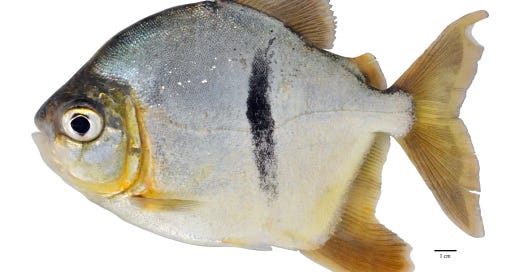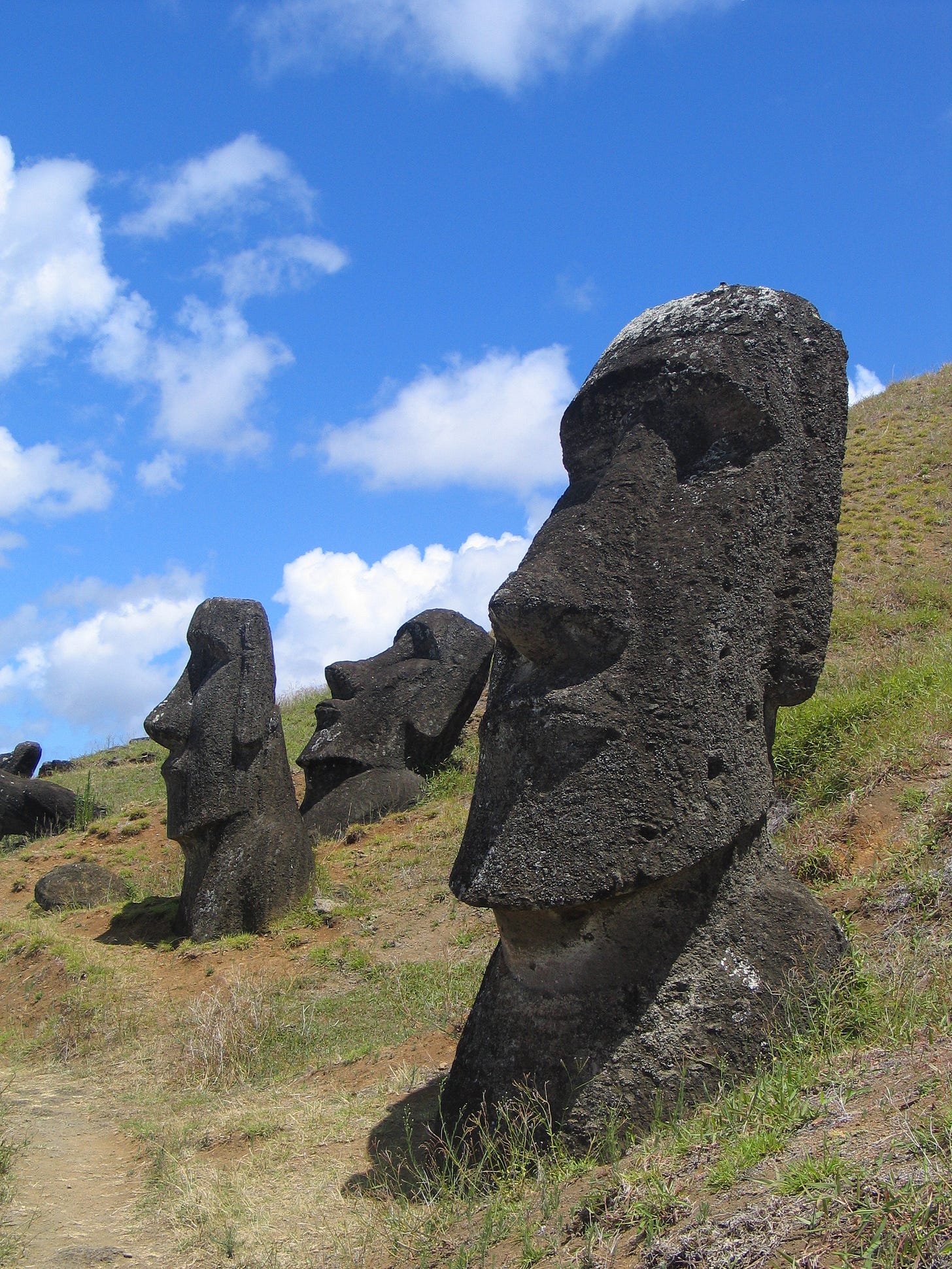by Richard Conniff
A VERY NEW LOOK FOR SAURON
Somebody on the CNN copy desk must have thought it sounded cool, so they headlined the story: “New species of piranha relative is named after Sauron from 'The Lord of the Rings'. A Satanic name for a piranha sort of fish. It fits, right? But piranhas are not evil incarnate. In truth, they are not even particularly dangerous, a point I made in my book Swimming With Piranhas at Feeding Time. (And, yes, I tested the idea myself, swimming in a tankful of them at the Dallas Aquarium, as well as in various parts of the Amazon.)
But this new species isn’t even a piranha. It’s a pacu, a fish with squared-off teeth for grazing like a cow on plants. Not in the same genus as piranhas, just the same taxonomic family. It reminds me of the time, in 2013, that the press jumped on the case of the “testicle-biting” pacu (with CNN also right there in the pack). That time, some reporter heard a joke about a nut-eating pacu, and made a wild leap to the wrong conclusion.
This time, though, the scientists get some of the blame. They say they chose the name because “The elliptical body of Myloplus sauron, marked with a vertical, black bar tapering toward both ends, resembles the famous vertical-pupilled eye from the novel.” Take a look for yourself (photo above). Is “Sauron” the name that slithers into your mind? We’re in the middle of a scientific controversy over naming species after humans who have turned out to be not such nice people. But, sure, why not name one after the character J.R.R. Tolkien described in The Lord of the Rings as “the ultimate evil” and “the destroyer of worlds.” That poor pacu has a lot to live up to.
(Further reading, for Tolkien fans who want to dive down this particular rabbit hole, and can get past the paywall: "Sauron, Mount Doom, and Elvish Moths: The Influence of Tolkien on Modern Science.”)
ANTIFREEZE IN THE MICROBIOME
All species depend for their survival on mutually beneficial partnerships with other species. It’s one of the great scientific revelations of our time. But what if your home address is Adelie Cove, Antarctica, and you live in the sediment at the bottom of the Ross Sea, largely isolated from the outside world for, oh, the past 34 million years?
Researchers at Italy’s Mario Zucchelli Station wanted to know how three species of cold-blooded polychaete worms living there don’t just survive, but thrive in the undersea sediment, despite sub-zero temperatures. They found the answer in the microbiome of these worms, and particularly in bacterial partners belonging to the genus Meiothermus and Anoxybacillus, according to a study published this week in the journal Science Advances. These bacteria produce ice-binding proteins “which are involved in preventing ice formation within cells and tissues and in lowering their freezing point.” That is, they serve as biological antifreeze.
Researchers have previously demonstrated antifreeze in certain fish, reptiles, insects, and bacteria. What’s surprising in this case is that Meiothermus and Anoxybacillus are the same bacteria previously found protecting animals from extreme heat in hydrothermal vents, geothermal fluids, hot springs, and other habitats. They’ve never been found before in extremely cold conditions. The research team found evidence that the worms and their dominant microbial partners have co-evolved together for millions of years. They use the term “phylosymbiotic,” meaning they are symbiotic not just in the here-and-now but in their evolutionary history, or phylogeny. They also credit the bacteria with “a versatile genetic makeup for different extreme temperature conditions, allowing them to produce enzymes and metabolites,” for adapting to extreme climate conditions.
It’s not just about keeping the little wrigglers from turning into icicles, the authors of the study suggest. In a world of rapidly changing climate conditions, the Antarctic worms and their highly adaptable bacterial partners may also be valuable “for the development of nature-based biotechnological applications.”
That is, they could be, um, useful.
EASTER ISLANDERS MAYBE DIDN’T COMMIT ECOCIDE
Ever since outside visitors first showed up in 1722, they’ve made Easter Islanders the object of what looks in retrospect like awestruck colonialist defamation. That is, they were wowed by the massive stone heads, called moai, guarding the periphery of the island, but also in disbelief that the island’s impoverished Polynesian inhabitants could have carved these monumental stones or moved them into place.
The Norwegian adventurer Thor Heyerdahl is still the best known of the defamers. He thought the moai were the work of red-headed Nordic voyagers, a lot like him, and once wrote that “with the arrival of the genuine Polynesians, all cultural life came to an end.” But Jared Diamond has rivaled him in recent decades, as the popularizer of the “ecological collapse” hypothesis. It’s the idea that the work to produce several hundred moai required a large population—some researchers have put the number as high as 17,000—which then deforested the island and degraded the habitat to the point that they were reduced to cannibalism.
“It was the islanders themselves,” Diamond wrote, in his 2005 book Collapse: How Societies Choose to Fail or Succeed, “who had destroyed their own ancestor’s work.” He used the term “ecocide.” (Full disclosure: I visited Easter Island for National Geographic in the early 1990s and, even before Diamond’s book, I wrote in the magazine that the “ecological collapse” theory of Easter Island was generally accepted.)
Skeptics abound, however, among them Columbia University’s Dylan S. Davis and his co-authors on a new paper in the journal Science. They argue that Easter Island’s population never got all that large in the first place and never experienced societal or ecological collapse. Instead, they say, the islanders practiced a sustainable form of agriculture that could have supported a maximum population of about 3900 people, about as many as lived there when European explorers first visited. They based that conclusion on archaeological evidence of the agricultural practice called rock gardening. That doesn’t mean landscaping with handsome or evocative rocks. It’s an ancient technique for improving poor soils by adding rocks, pulverized and whole, to prevent moisture loss and reduce nutrient leaching.
Previous studies of the rock gardens were limited to what could be seen on the surface and by the low-resolution satellite imagery available at the time. The new study was based on five years of high resolution shortwave infrared and near-infrared satellite data, which allowed researchers to peer through existing vegetation to the rock gardens below. They say previous estimates of the extent of these gardens were 5 to 20 times too high, resulting in the overestimate of the island’s maximum population.
Based on the much smaller extent of rock gardening revealed by the new satellite imagery, they write that “the island’s carrying capacity would also be substantially less than previous claims, even under optimistic assumptions of high productivity.” Adding in the nutrition available from fishing and other marine food foraging, they concluded that Easter Island was never home to more than 3900 people.
One question the new study doesn’t address: How to accommodate the sustainability theory with the deforestation of Easter Island, the extinction of six species of native land birds, and the loss of a thriving seabird colony, all said by collapse proponents to have been caused by human overharvesting and introduction of tree rats and other non-native species.
OTHER NEWS OF INTEREST
For ecosystem collapse, look at wolf removal in the American West
"The historic removal of gray wolves from the U.S. West facilitated the rise of mid-ranking predators across the region, wreaking havoc on historical ecosystem dynamics, a new study has found."
Rhino poachers are still at it in Kruger National Park. But there aren’t as many rhinos to poach.
Rhino poaching rates in South Africa’s Kruger National Park have dropped since 2015. “But that’s not a positive sign,” Jasper Eikelboom and Herbert Prins write, because there are now far fewer rhinos to hunt. They estimate that the average distance poachers must travel before stumbling upon a rhino in Kruger has quadrupled from 7 kilometers in 2015 to 29 kilometers in 2022. But poaching pressure on rhinos has remained unchanged since 2013, despite enforcement measures.
Insecticides are the primary driver of butterfly decline
Habitat loss, climate change and pesticides have all been implicated as potential causes for the steep decline in insect populations worldwide. The first comprehensive long-term study to evaluate their relative effects evaluated 17 years of data on land use, climate, multiple classes of pesticides, and butterfly survey data across 81 counties in five states. The result: Shifts in insecticide use toward neonicotinoid-treated seeds are associated with an 8% decline in the diversity of butterfly species across the American Midwest. Insecticides rather than herbicides are the strongest pesticide factor linked with monarch butterfly declines.
No, dinosaur fossils did not inspire the griffin myth
In the first detailed assessment of claims made popular in the 1990s about the origin of mythological griffins, paleontologists Mark Witton and Richard Hing at the University of Portsmouth re-evaluated historical fossil records, the distribution and nature of Protoceratops fossils, and classical sources linking the griffin with the Protoceratops. They also consulted with historians and archeologists to fully understand the conventional, non-fossil based view of griffin origins. The bottom line: This geomyth collapses under scrutiny.






I've enjoyed a number of your books and appreciate you as a communicator, so I felt you should get some financial reward for it all!
Thank you for all the information and insight. I will, however, continue to share the idea of the Griffin and the protoceratops. Now, though, I will present it with a different amount of certainty.
Damian